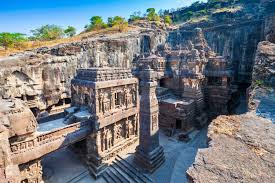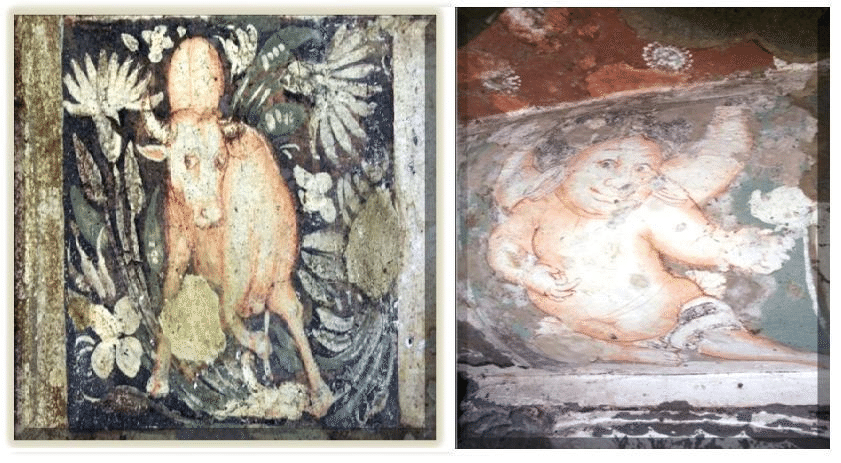Artists carved this monolithic marvel, dedicated to Lord Shiva, out of a single rock.

The Ajanta and Ellora Caves in Maharashtra, India, stand as UNESCO World Heritage Sites that celebrate India’s artistic brilliance, spiritual depth, and architectural mastery. These ancient rock-cut monuments captivate art lovers, historians, and travelers from around the world.

The Ajanta Caves are famous for their breathtaking mural paintings and rock-cut sculptures. Carved into a horseshoe-shaped cliff, this complex of 30 Buddhist caves reflects over 1,500 years of cultural and spiritual heritage.
Artists used the tempera technique (painting on dry plaster) instead of fresco.
Natural colors like red ochre, lapis lazuli, chalk, and charcoal created rich and lasting hues.
The paintings portray expressive faces, graceful figures, and intricate ornamentation, giving them a lifelike, almost three-dimensional feel.

Gautam buddha sculpture

Gautam buddha painting
The painting is celebrated for their expressive faces, graceful lines, and intricate detailing, showcasing both artistic skill and deep religious devotion.
“The Ajanta Cave is more than a monument—it’s a masterpiece of Buddhist heritage carved into stone.””No brush could recreate the emotion that the Ajanta Cave walls have carried for centuries.”

Three dimensional painting
The three-dimensional painting in the Ajanta Caves refers to the illusion of depth and volume created by ancient Indian artists on flat surfaces. Using techniques like shading, perspective, and overlapping, they made the figures appear lifelike and spatial. This mastery is especially evident in the expressive faces, intricate garments, and natural postures of the figures, giving a realistic, sculptural feel despite being two-dimensional wall paintings. These artworks primarily depict scenes from the Jataka tales showcasing the high level of skill in ancient Indian art.
“Carved into the heart of a horseshoe-shaped cliff, the Ajanta Caves whisper tales of devotion, art, and ancient Indian splendor.

Dancing girl in Ajanta Cave painting
Their pose and grace represent not just physical beauty, but also spiritual and artistic refinement.The painting depicts a group of dancing women, captured mid-movement with expressive gestures and flowing garments. They are adorned with jewelry and elegant hairstyles, highlighting the cultural richness and refined artistic style of the Gupta period (5th century CE). Found mainly in Cave 1 or Cave 2, these figures reflect joy, celebration, and the sophisticated life of the court or divine realms.
Scenes from Buddha’s life and Jataka tales narrate stories of compassion, sacrifice, and wisdom.
Iconic figures like Bodhisattvas Padmapani and Vajrapani symbolize spiritual ideals.
Court scenes, dancing figures, and daily life capture the sophistication of the Gupta period.
Gautam Buddha in Mahaparinirvana: A serene 24-foot sculpture of Buddha lying on his right side, embodying ultimate liberation.
Three-Dimensional Paintings: Artists used shading, perspective, and overlapping to create an illusion of depth on flat walls.
Dancing Girl Murals: Found in Cave 1 and Cave 2, these paintings show mid-movement grace, flowing garments, and jeweled adornments, symbolizing joy and artistic refinement.
“Each wall of the Ajanta Caves is a canvas where stone meets spirit, narrating the life of Buddha in strokes of silence.”
“No brush can recreate the emotions that these murals have preserved for centuries.”
Unlike Ajanta, the Ellora Caves showcase a fusion of Buddhism, Hinduism, and Jainism, reflecting India’s religious harmony. This complex of 34 caves is celebrated for its sculptural grandeur rather than painted murals.
Dynamic rock-cut sculptures depict gods, mythological scenes, and celestial beings.
The Kailasa Temple (Cave 16)—
Jain caves (Caves 30–34) highlight intricate detailing, ascetic ideals, and spiritual symbolism.
Together, Ajanta and Ellora represent a blend of art, spirituality, and philosophy, offering insights into ancient Indian society and its aesthetic evolution. Today, they trend as must-visit destinations for heritage tourism, attracting global travelers and art enthusiasts alike.